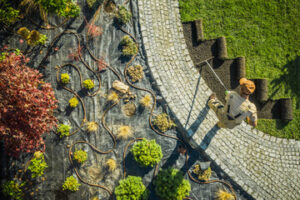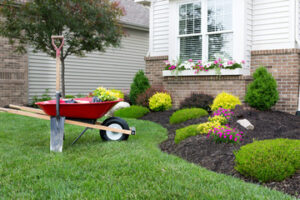Landscaping is an excellent way to increase the resale value of your home. It also creates a great first impression for potential buyers, which can result in more inspections and higher sale prices.
A well-designed landscape includes elements like lawns for kids and pets, shrubs for structure and color, and trees for shade and beauty. It is important to use a combination of plants that can thrive in your climate and soil type. Visit Website to learn more.
1. Increases Property Value

Landscaping adds beauty and charm to a property, which can help increase the value of your home. It also helps improve air quality, creates usable outdoor spaces, and prevents erosion and water runoff. Additionally, landscaping can reduce noise pollution and protect against wind damage.
Landscapers can also incorporate different elements to create a harmonious look between your indoor and outdoor living areas. This can include outdoor lighting, water features, and fire pits to maximise your outdoor space.
Landscaping also has other practical benefits, such as providing shade, privacy, and noise protection. In addition, it can help lower energy costs by reducing the need for air conditioning. Furthermore, trees and shrubs can act as a natural coolant by shading buildings in the summer and helping reduce the urban heat island effect.
2. Reduces Stress
Landscaping can make your outdoor space a relaxing retreat that you and your family can enjoy. Spending time in the great outdoors has been shown to reduce stress, lower blood pressure and heart rate, and boost moods. But it’s not always possible to get away for a weekend or holiday, so having a relaxing backyard landscape can give you a place to escape from the everyday stresses of life.
A well-designed landscape can also provide a natural privacy barrier and reduce noise pollution from nearby roads or neighbors. And if you choose plants that produce fragrances, they can be effective pest repellents as well. Gnats, flies, mosquitoes, and other annoying insects don’t like the scents produced by certain flowers or trees, which can drive them away.
In addition, a properly designed and maintained landscape can help save on energy costs by providing natural shade and wind protection. This can reduce the need for air conditioning and heating, which can save you money on your monthly utility bills.
3. Increases Air Quality
The hidden environmental benefits of thoughtful landscaping are many and powerful. For example, the cooling shade provided by trees and the air-purifying qualities of greenery can mitigate urban heat and improve air quality in cities, while also fostering social cohesion and encouraging environmental stewardship among residents.
Trees, plants and grasses absorb carbon dioxide and release oxygen through photosynthesis, which helps to reduce the amount of ozone produced in the atmosphere2. They also act as natural air filters, trapping and breaking down pollutants as they move through the environment. They can even provide a barrier or a ‘green screen’ to protect people from pollution emitted by vehicles and traffic, which has been shown to halve the level of air pollutants immediately behind the green space3.
Additionally, native vegetation promotes healthy soils that reduces erosion, runoff and the movement of pesticides, fertilizers, and other pollutants into water sources. Grass with a wide root system stabilizes the soil, while trees and shrubs with deep roots keep them in place, decreasing the need for maintenance equipment that emits ozone-forming volatile organic compounds (VOCs) and contaminates groundwater with nitrogen and phosphorous4. Landscapes with a mix of native vegetation require less water and nutrients and help to protect against erosion, flooding and wildfire.
4. Increases Property Value
With the current housing market volatility, many homeowners are cautious about investing in home improvements that won’t have a positive return when it comes time to sell. However, experts have found that landscaping is one of the best ways to increase a property’s value. In fact, prospective buyers form their first impression of a house in less than 12 seconds, so a well-kept lawn and vibrant plants are crucial to creating curb appeal.
According to a study by the Appraisal Institute, landscaping adds 5.5% to 12.7% to a property’s appraisal value. While some landscaping projects take years to mature (such as trees), other projects can be done relatively quickly and easily, such as laying out a garden or installing a water feature.
In addition to increasing the aesthetics of a property, landscape design can also improve its function and reduce maintenance costs. For example, strategically placed trees can lower energy bills by shading homes in the summer and protecting them from cold winds in the winter. Additionally, many plants can act as natural pest repellents, as they emit scents that are unpleasant to gnats, flies, and mosquitoes. Additionally, xeriscaping and other sustainable landscaping techniques can significantly lower water usage and reduce upkeep costs.
5. Reduces Noise Pollution
Landscaping not only improves the look of your property, but it can also block out unwanted noise. Several tools are available for reducing noise pollution, including buffer walls, trees, and fountains that mask offensive sounds. The best solution is to choose an option that combines a barrier with plantings. The leaves, branches, and bark of plants absorb sound waves, while buffer walls deflect them and reduce their intensity.
In addition to helping to block out noise, well-designed landscaping can also be a natural water cleaner and provide habitats for wildlife. Healthy lawns and plants naturally absorb carbon dioxide, producing life-giving oxygen (a single tree can produce enough oxygen for a family of four). They also slow down runoff from stormwater into nearby bodies of water, preventing soil erosion and protecting the environment.
In modern urban and suburban areas, the symphony of traffic and city noise can become a cacophony that makes it difficult to find tranquility. Fortunately, incorporating specific plants and innovative sound barriers into your landscape can help combat the problem. For example, dense hedges are effective sound barriers that can be planted to create a soft boundary while maintaining the pre-established aesthetic of your property.
6. Increases Property Value
The value of your property depends on how well you maintain it, and landscaping is one of the best ways to increase your home’s value. In fact, according to a University of Florida study, homes with beautiful landscaping sold for 15% more than similar houses without it.
In addition, landscaping creates a pleasant and welcoming atmosphere for potential buyers and helps them envision themselves living in the house. However, the key is to keep the landscaping simple and consistent with the architectural style of your home or commercial property. A landscape that looks piecemeal can turn off buyers.
Landscaping is also good for the environment, and a properly planned and maintained yard can help protect the watershed. For example, trees and shrubs provide natural shade, reducing temperatures and mitigating the urban heat island effect. They can also reduce erosion, filter runoff, and replenish groundwater resources.
In a recent survey, real estate agents indicated that the presence of a single healthy tree in the front yard significantly increases a home’s value. They also report that a well-manicured lawn, attractive plants in flower beds and garden areas, and a deck or outdoor kitchen all increase a home’s value.
7. Increases the Value of Your Home
Landscaping is an inexpensive way to increase the value of your home. For example, adding a simple patio or walkway can increase your home’s value by up to 15%. Planting trees is another cheap landscaping project that can boost your home’s value by up to 5%.
Buyers are often more interested in homes that have attractive and well-maintained gardens. This is because it shows that the homeowners care about their property and take pride in it. It’s also a good way to differentiate your house from the competition as it gives a positive first impression to potential buyers.
According to a study by Virginia Tech, properties with well-maintained and landscaped yards have up to a 15% higher value than those without it. In addition, it reduces time spent on the market and offers an excellent return on investment.
Moreover, landscaping provides several environmental benefits such as improving air quality and promoting biodiversity. It also helps prevent soil erosion and manage water runoff. It even helps cool your home in the summer by reducing temperatures through the shade of trees and plants. Additionally, many plants are natural pest repellents due to their fragrant oils. They can help you get rid of gnats, flies, mosquitoes and other insects that bother you.
